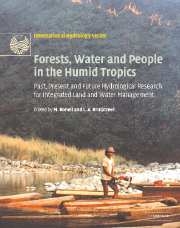 Forests, Water and People in the Humid Tropics
Forests, Water and People in the Humid Tropics from Part IV - New methods for evaluating effects of land-use change
Published online by Cambridge University Press: 12 January 2010
INTRODUCTION
Increasingly, the monitoring of forest condition and productivity requires better spatial context, more detail and higher temporal resolution, if we are to be able to visualise key environmental or biodiversity indicators and their changes across space and time. For the accurate prediction of how changes in climate, forest condition or land-use can impact large-scale hydrological processes, researchers and water managers are also faced with the need to extrapolate patch-scale measurements to whole catchments or river basin scales. This is especially challenging across large, often inaccessible areas or where the ground information available is sparse and where the costs and effort required in setting up a dedicated, sufficiently dense network of ground-based sampling sites are very high.
Although not always measuring the required hydrological variables directly, remote sensing techniques can provide valuable information about the spatial variability of key surface characteristics across large scales. For this reason it is often used as a cost-effective mechanism for extrapolation of point-based measurements, or as a constraint for hydrological model outputs. The key to the effective use of this type of data, in conjunction with hydrological models, lies in the recognition of the characteristics and trade-offs found in the different forms of remotely sensed derived variables, and how they can be used to complement ground-based hydrological measurements effectively.
Up to now, mostly broad-band, low resolution remotely sensed data have been used as input and constraints for regional/ continental hydrology and productivity models (e.g. Running and Coughlan, 1988; Schultz and Engman, 2000).
To save this book to your Kindle, first ensure [email protected] is added to your Approved Personal Document E-mail List under your Personal Document Settings on the Manage Your Content and Devices page of your Amazon account. Then enter the ‘name’ part of your Kindle email address below. Find out more about saving to your Kindle.
Note you can select to save to either the @free.kindle.com or @kindle.com variations. ‘@free.kindle.com’ emails are free but can only be saved to your device when it is connected to wi-fi. ‘@kindle.com’ emails can be delivered even when you are not connected to wi-fi, but note that service fees apply.
Find out more about the Kindle Personal Document Service.
To save content items to your account, please confirm that you agree to abide by our usage policies. If this is the first time you use this feature, you will be asked to authorise Cambridge Core to connect with your account. Find out more about saving content to Dropbox.
To save content items to your account, please confirm that you agree to abide by our usage policies. If this is the first time you use this feature, you will be asked to authorise Cambridge Core to connect with your account. Find out more about saving content to Google Drive.